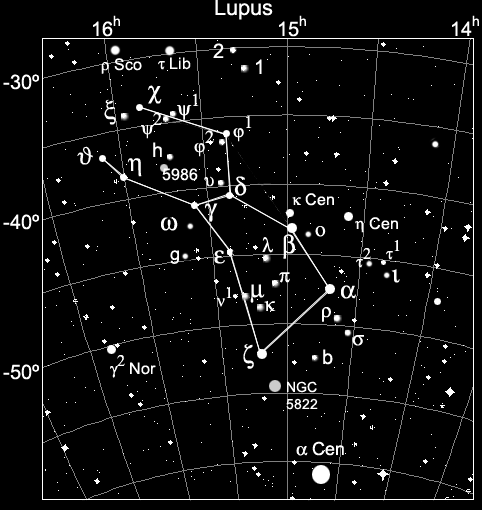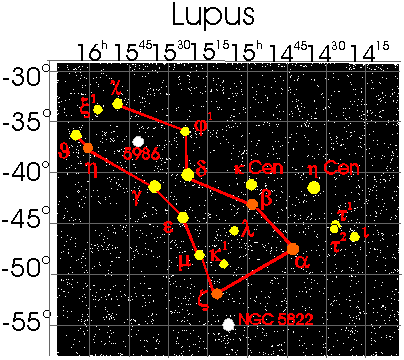
Although relatively unknown Lupus is surprisingly occupied by a number of interesting objects, some suitable for binoculars. Lupus extends from the southwest of Antares (in Scorpius) to nearly as far south as the two bright stars in Centaurus, alpha and beta. A prerequisite study would be Centaurus.

Alpha Lupi, a blue giant 550 light years away, forms the southwestern corner of the asterism. It's easily found by moving due north of alpha Centauri eleven degrees, or due east from zeta Centauri a little more than one FOV. Beta, the second brightest star, is just north-northeast of alpha, in the same FOV.
Beta Lupiis blue-white star 525 light years away. It's in the same FOV as alpha. From beta you can move over to the eastern edge of the asterism. If you place epsilon at the southwestern edge, you'll see gamma Lupi. Now put this star in the same southwestern position and then move the glasses slightly to the northeast. Eta moves into view. Just northwest of eta is theta.
Eta Lupi is a fine binocular double: 3.4, 7.8 magnitudes, 20º with a separation of 15". The difference in mag may make it difficult to resolve except with larger binoculars. To find the star begin at Antares and move due south two binocular fields (where two bright stars, H and N Sco will be centred) then move one binocular field to the southwest. Alternatively, you can starhop from alpha-beta-epsilon-gamma then move one binocular field northeast of gamma.
Zeta Lupi forms the southern-most point in the asterism. It's found southwest of alpha a little more than one binocular FOV. Or move directly east from alpha, where you'll encounter mu Lupi. Zeta is in the same FOV.
Just south of zeta, barely in the same FOV (if mu is at the upper edge) is the open cluster NGC 5822, about a hundred stars spread over a large field.
